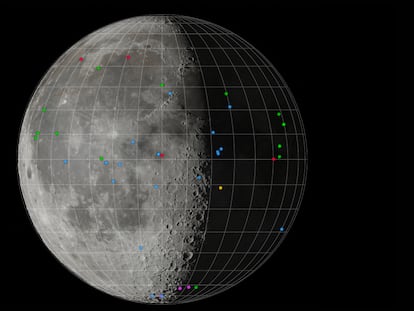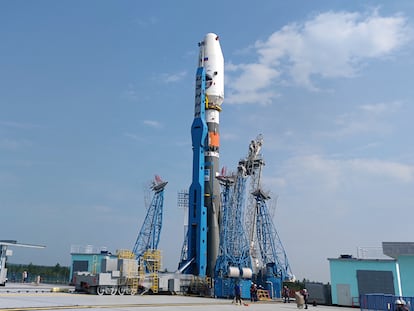New space race reignites the epic of lunar probes half a century later
The Russian ‘Luna-25,’ which is heading towards the south pole of the Moon, is the first in a series of probes from several countries that will explore its surface in the coming years
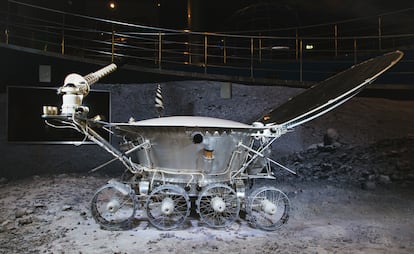
After a 47-year hiatus in its lunar exploration program, Russia is about to return to the Earth’s satellite. The newly-launched probe is number 25 in the Luna historic series of spacecraft, which gave the now-defunct Soviet Union some of its greatest successes in the early years of the space race.
These capsules, which at first were simple metal spheres crowned with antennae and instruments, marked great milestones in the history of space exploration since 1959. Luna-1 was the first artificial planet; it received that title after it was left orbiting the Sun when its aim failed by 6,000 kilometers (it was supposed to crash into our satellite). Number 2 was the first artificial impact on the Moon and number 3 obtained the first photographs of its hidden face; even though they were of poor quality, they caused quite a stir. Later, Luna-9 soft-landed in 1966, and that same year Luna-10 became the first human artifact to orbit a body other than Earth. The USSR scored all those partial victories before the final victory that was the arrival of the U.S. astronauts in 1969.
By the end of 1968, the Soviet Union had already come to terms with the fact that the race to the Moon would be won by the Americans. The Soviet manned ship, and especially the rocket that was supposed to launch it, had been delayed too often. One last chance to scrape out a bit of prestige would have been to send a pair of cosmonauts to complete the first circumlunar voyage and leave the Moon landing to their American competitors, but the flight of the Apollo 8, on Christmas Eve 1968, dashed those hopes.

After that disappointment, the official mantra was imposed: denying that the USSR had lost the race, as it had never actually intended to participate in it. It would not be until Mikhail Gorbachev’s glasnost that Moscow would acknowledge the existence of a poorly managed, poorly financed manned lunar program. In spite of everything, the USSR had a plan B. A few years ago, the Lavochkin company, which had built the first lunar probes, began to work on the next generation, based on a landing platform capable of carrying different types of loads, among them, an automatic sample collection capsule or a rolling vehicle.
Thanks to Luna-16, launched only a year after the arrival of the Americans, the Soviet Union obtained its first samples of regolith in 1970. Just 3.5 ounces, collected on the shore of the Mare Fecunditatis plain — the eye of the face that some see in the lunar disk. It was a great technological feat. The capsule, with its valuable cargo, lifted off from the Moon on a direct vertical ascent trajectory that would hurl it towards Earth like a cannonball, with no course corrections. While plunging into the atmosphere (at more than 6 miles per second), it experienced a brutal deceleration of 350 G, fifty times more than what astronauts making the same journey could withstand.
Not two months had passed when the Luna-17 took off. The landing platform was identical, but this time it carried a curious wheeled vehicle: the first Lunokhod. For some, its clumsy appearance and the double television camera that resembled eyes made it amusing; others simply found it ugly, like some sort of moving bathtub. It consisted of two sections: the chassis, with eight wheels (plus another that served as an odometer), was capable of withstanding the roughest treatment; not for nothing its engineers had gained experience designing tanks. It lacked a steering system, so in order to turn, it moved the wheels on one side and stopped those on the opposite.
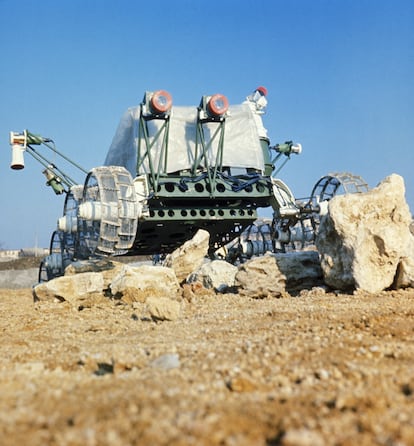
On the chassis there was an airtight compartment that carried the scientific equipment, the radio and the batteries. A lid opened at sunrise, exposing the bank of photoelectric cells, and closed at night to protect it from the cold. It was projected for a useful life of three months (three full lunar days) but resisted for almost a year, traveling about six miles and carrying out hundreds of tests to determine the composition of the soil and its mechanical resistance. Afterwards, it was abandoned for many years until it was detected by a photographic satellite in 2010. Its laser reflector still works.
Those two Luna missions, so close in time, constitute one of the great achievements of Soviet astronautics during those heroic years. Others would follow: two to collect samples and another to take a second Lunokhod vehicle. This one, by the way, traveled 25 miles, further than any rover manned by the astronauts of the Apollo program.
About six years ago, the Lavochkin company offered the Lunokhod 2 for auction at Sotheby’s. Richard Garriot, a video game designer, paid almost $70,000 for it, even though it is parked in the Le Monnier crater and can never be brought back to Earth; for him, knowing that the only privately owned vehicle on the Moon belongs to him is enough. There is a third model, more advanced than its two siblings, but in the end it did not fly due to financial problems. Today it is one more piece in the Lavochkin museum, near Moscow.
Other Soviet launches followed in the 1970s: one, orbital, to photograph and analyze the composition of the surface using remote sensors, and two more for sample collection. And the Luna-24, the last in the series, had a 6.5-foot drill bit that made it possible to obtain samples of deep rock. In total, Russia now has nine ounces of lunar material.
The new generation
Luna-25 is an entirely new probe, although it still takes advantage of the original moon landing platform design. Its main goal is to check the operation of the modern systems that control it, landing in an area of the Aitken basin, near the lunar south pole. There, the Sun’s rays arrive so tangentially that they never reach the bottom of some craters. In fact, the Luna-25 does not have its solar panels on top, but on its sides, to make better use of the light. These dark oases house some deposits of frozen water, as confirmed in 2009 by the first Indian space probe, Chandrayaan 2.
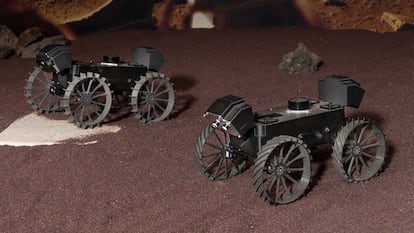
If all goes well, Luna-25 may be the first vehicle to physically scratch the Moon’s ice. However, it is not alone in the race. Since mid-July, another Indian probe has been making its way to the same target, albeit following a much slower trajectory. Previously, in 2019, the Vikram, also from the Indian Space Research Organization, crashed while trying to land at 70 degrees south latitude.
Other recent attempts to land on the Moon (although not in the polar regions) have not been successful either: the Israeli probe Beresheet in 2019, as well as the Japanese Hakuto-R lander, which carried a small rover built by the United Arab Emirates. Now, the Japanese space agency (JAXA) is experimenting with new technologies, from the semi-soft moon landing, using airbags (a first test failed last year) to a horizontal descent.
As for NASA, apart from the almost $8 billion that it has allocated to its Artemis program (divided among consortia led by the companies of Elon Musk and Jeff Bezos), it has established contracts with at least four other smaller private companies to develop autonomous landers and rovers. The U.S. plans to send three mini rovers in 2024 that will coordinate without direct human intervention to map the lunar surface in 3D, using cameras and ground-penetrating radar. The Moon, especially its south pole, is going to be quite crowded for the next few years.
Sign up for our weekly newsletter to get more English-language news coverage from EL PAÍS USA Edition
Tu suscripción se está usando en otro dispositivo
¿Quieres añadir otro usuario a tu suscripción?
Si continúas leyendo en este dispositivo, no se podrá leer en el otro.
FlechaTu suscripción se está usando en otro dispositivo y solo puedes acceder a EL PAÍS desde un dispositivo a la vez.
Si quieres compartir tu cuenta, cambia tu suscripción a la modalidad Premium, así podrás añadir otro usuario. Cada uno accederá con su propia cuenta de email, lo que os permitirá personalizar vuestra experiencia en EL PAÍS.
¿Tienes una suscripción de empresa? Accede aquí para contratar más cuentas.
En el caso de no saber quién está usando tu cuenta, te recomendamos cambiar tu contraseña aquí.
Si decides continuar compartiendo tu cuenta, este mensaje se mostrará en tu dispositivo y en el de la otra persona que está usando tu cuenta de forma indefinida, afectando a tu experiencia de lectura. Puedes consultar aquí los términos y condiciones de la suscripción digital.
More information
Archived In
Últimas noticias
Maduro pleads not guilty before the federal court in New York: ‘I am still the president of Venezuela’
A new test can detect Alzheimer’s from a finger prick
UN team enters Sudanese city of El Fasher after paramilitary massacre: ‘It’s like a ghost town’
A recipe for resistance: Indigenous peoples politicize their struggles from the kitchen
Most viewed
- Gilles Lipovetsky: ‘If you want to live better and fall in love, take Prozac, don’t look to philosophy’
- Alain Aspect, Nobel laureate in physics: ‘Einstein was so smart that he would have had to recognize quantum entanglement’
- Alvin Hellerstein, a 92-year-old judge appointed by Bill Clinton, to preside over Maduro’s trial in New York
- Maduro’s downfall puts China’s relationship with Venezuela to the test
- Why oil has been at the center of Venezuela-US conflicts for decades

